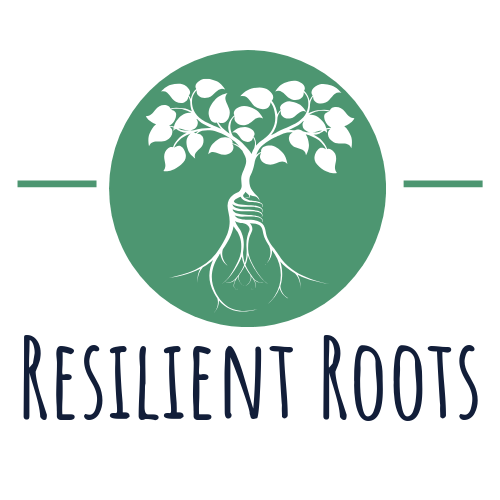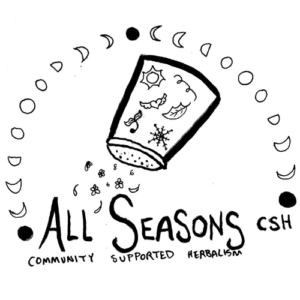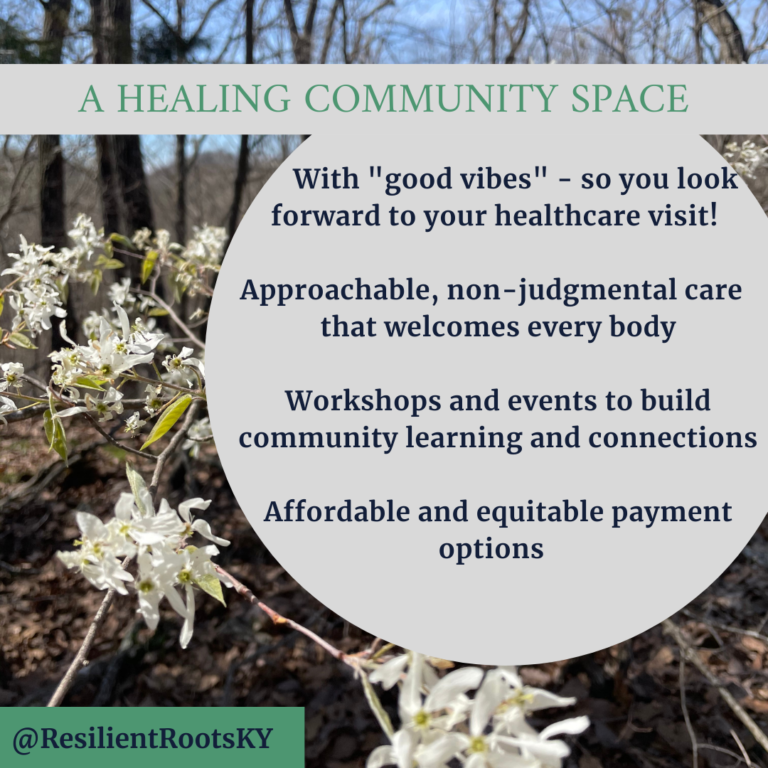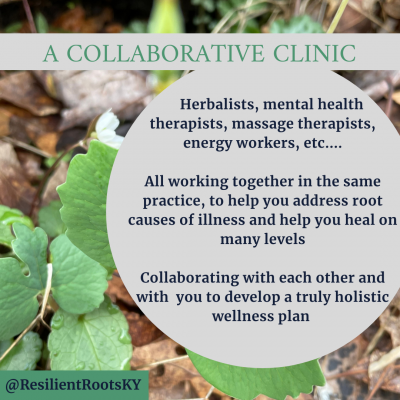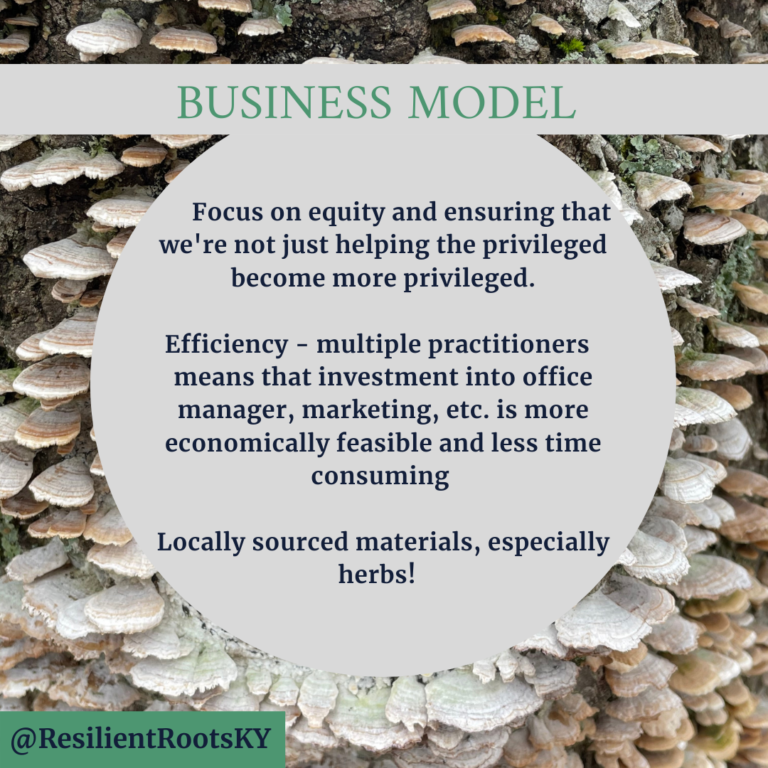All herbs are locally grown, organic, and/or wildcrafted using sustainable, natural, chemical free growing practices. Most come from my gardens and land in Berea, KY, and I occasionally purchase fresh herbs from local growers whose growing practices are aligned with mine (such as Among the Oaks). Everything is made by hand, in small batches, in a commercial kitchen, with focus on the optimal methods of extracting the full spectrum of medicine from the plants. A portion of the sales from these products go toward my free clinic and to providing sliding scale medicine to others in need.
All prices listed below are +tax, except for the dried herbs, which are considered food items and are exempt.
Shipping and handling is $10.
To order:
- Email product names and quantities (for tinctures, specify 1 oz, 2 oz, or 4 oz) to Lauren@ResilientRootsKY.com
- Send me your address if I’m shipping it to you (you may also pick up in Berea)
- I will send you an invoice or if you prefer to Venmo, I’ll email you the total amount with tax and shipping.
Product list
Special offering – Winter Wellness kit – $50: includes items I’ve used for many years to manage the various respiratory illnesses that we encounter this time of year. It will include:
- A loose leaf tea with anti-microbial, anti-viral, and decongesting properties
- A immune supporting tincture (herbs extracted in alcohol and water) that helps kick the krud (2 oz bottle)
- A fire cider oxymel (herbs extracted in vinegar and honey) to help clear your respiratory system and support your immune system (4 oz bottle)
- Packaged in a gift box with an instructional card on how to use the items
Dried herbs/tea blends
| Product Name | Description | Price |
| Holy basil | Dried leaf, makes a great tea on its own or blended with other herbs. 1 oz. | $10 |
| Good Nite | Designed to support your nervous systems for a relaxing nighttime tea. Ingredients: lemongrass, catnip leaf and flower, anise hyssop, and Korean mint (Agastache rugosa) grown naturally on our farm | $12 |
| “Pregnancy Tea” | – raspberry leaf, alfalfa leaf, nettle leaf, oatstraw, lemon balm – all nourishing, mineral rich herbs to help support the body during pregnancy….But it is a useful blend for almost everyone, not just pregnant folks! | $15 |
Tinctures from the farm
Tincture: alcohol and water herbal extract from fresh plants unless otherwise noted
Suggested use: will be listed on bottle. Typically, people either squirt directly into mouth or add to water in a glass. 1 full squeeze of the dropper bulb = 1 dropper = 1 ml = approx. 20 drops
Most of these are also available in 2oz and 4oz quantities, offering a bit of a discount from the 1 oz price.
1 oz = $15; 2 oz = $28; 4 oz = $50
1 oz = $13; 2 oz = $25; 4 oz = $45
1 oz = $20; 2 oz =$36; 4 oz = $70
| Product Name | Description | 1 oz Price |
| Ashwaganda tincture | So many medicinal uses, ashawaganda is a popular adaptogen (modulates HPA axis and stress response) and may also be helpful for muscle and joint pain, mood, and more! | $15 |
| Black cohosh tincture | Very selectively wildcrafted roots with replanting of buds to ensure the plant survives, which is a labor-intensive process! This is a lower dose herb so a little goes a long way. Popularized as a menopausal tonic, it has many more virtues, including hormone balancing (for any age), anti-spasmodic (helpful for cramps and muscular tension), anti-inflammatory, nervous system nourishing, mood lifting. | $20 |
| CA Poppy | Calming, relaxing, pain relieving. A great sleep herb! Made from the entire fresh plant. | $15 |
| Catnip tincture | Has the opposite effect in humans vs. cats! Carminative (relaxes gut to expel gas), antispasmodic, nervine (soothing to nerves). Specific for stress induced gastric issues. Can be used with children in small amounts to help them with fevers, colic, insomnia and nausea. | $13 |
| Dandelion root tincture | Another herbal medicine chest! This makes a great base for a “bitters” blend, making it wonderful for digestion and liver support. Also anti-inflammatory and supports healthy joints. | $15 |
| Echinacea tincture | Fresh Echinacea purpurea leaf and root extract. Contains all the tongue-tingly alkylamides that indicate good medicinal potency. Wonderful for the immune and lymph systems. Take in larger doses at the first sign of illness ~ 1tsp up to 5x/day or smaller doses more frequently. | $13 |
| Elderflower tincture | Fresh extract of the flowers – many herbalists consider more medicinally useful than the berries. Similar antiviral properties and also aids in fever reduction through its ability to move heat out of the body. | $16 |
| Elecampane tincture | Fresh extract from elecampane roots. Lung tonic and anti-inflammatory, consider for green mucus in congested lungs that is difficult to expel. Helpful as tonic for people with chronic respiratory issues. | $15 |
| Feverfew tincture | Fresh leaf and flower extract. Super anti-inflammatory, often used for head pain and seasonal allergies. Bitter, aromatic, cooling. | $13 |
| Goldenrod tincture | For acute respiratory issues it is helpful for clearing mucus and inflammation in the sinuses, making it popular for seasonal allergies. It is also nice in combination with lymphatic and antimicrobial herbs for infection. For chronic allergies, its best used in combination with immunomodulating (ex: holy basil) and liver support herbs (ex: dandelion, docks, milk thistle). Urinary antiseptic, tonic, and anti-inflammatory for infections, structural weakness | $13 |
| Goldenseal tincture | Extraordinary mucus membrane tonic, anti-fungal, anti-viral anti-microbial, digestive bitter. Topical antiseptic. A little goes a long way! Sustainably harvested from my property. | $20 |
| Hawthorne Berry tincture | Special extraction in Brandy, combination of fresh and dried berries. Physical and emotional heart support, good source of antioxidants. | $15 |
| Holy Basil (aka tulsi) tincture | Stress support (adaptogen), antibacterial, antiviral, mood enhancing, immune balancing, blood sugar stabilizing, supports healthy blood pressure, anti-inflammatory, brain and nervous system tonic (really its good for almost everything!) | $13 |
| Holy Basil glycerite | See above – extracted with glycerin instead of alcohol | $13 |
| Hops tincture | Supremely sleep-inducing, calming, relaxing. Super bitter and great for digestion! | $15 |
| Kava tincture | Fresh Hanakapai’ai Kava root extract. Supremely relaxing, helpful for easing tension, anxiety, and anger. Can also be used as a “social lubricant” in a similar way as alcohol, without the negative effects! I splurged and had this Kava shipped to me fresh from Hawaii – maybe a once in a lifetime medicine making experience! | $18 |
| Lavender tincture | fresh lavender flower, stem, and leaf (L. Angustifolia) extracted in grain alcohol All the relaxing benefits of lavender that you know and love😊 Great for sleep | $15 |
| Lemon balm tincture | Anti-viral, mood boosting, nourishing to nervous system, relaxing to digestive system, full of antioxidants. Also makes a nice addition to cocktails or soda water. | $13 |
| Milky oats tincture | Restorative to nervous system, this is made from fresh milky oat seed. A must for anyone with frazzled nerves. | $15 |
| Motherwort tincture | Calming, analgesic, nervine, antispasmodic, emmenagogue (supports menstrual cycle), hypotensive, very supportive to female reproductive system across the life spectrum for menstrual-related issues, post-partum pain, hot flashes and peri-menopausal woes. Calms and nourishes the physicial and emotional heart. | $13 |
| Mullein leaf tincture | Lung anti-inflammatory, it helps expectorate mucus and soothe irritated mucus membranes. | $13 |
| Nettle leaf tincture | Superfood, anti-inflammatory, anti-histamine qualities. | $15 |
| Passionflower tincture | Supreme sedative nervine and hypnotic (sleep inducing) | $15 |
| Reishi tincture | From Ganoderma tsugae harvested in the Daniel Boone National forest, this is triple extract of alcohol, glycerin, and water to preserve all the medicinal goodness. So many uses, from a heart tonic to immune balancing. Also a good to use as an overall daily health tonic. | $15 |
| Respiratory ease tincture | Fresh mullein and elecampane to support lung health, ease inflammation, and help expel mucus. | $13 |
| Rosemary tincture | Supreme antioxidant, support liver, brain, mood, circulatory tonic, anti-inflammatory, etc…. Helps raise the spirit. | $13 |
| Sage tincture | Many medicinal qualities…highlights include anti-infective, may help soothe sore throat, provides antioxidants, cool and dry the body in times of too much sweat or hot flashes, and so much more! | $13 |
| Skullcap tincture S. laterifolia | Supremely relaxing nerve tonic, anti-spasmodic, may be helpful for restless legs, tremors, depleted nervous system, middle of the night wakefulness. | $15 |
| Spilanthes tincture Aka “toothache” plant | Mouth numbing, saliva-encouraging, and immune activating tincture from spilanthes flowers grown on Lauren’s farm. A little goes a long way! – offering in 0.5 bottles | $10 (0.5 oz) |
| St. John’s Wort tincture | Soothing and restoring to the nervous system. Also a significant anti-viral and clinically studied for its anti-depressant effects. | $15 |
| Turmeric tincture | Made with fresh rhizomes from an organic farm in Casey Co., KY, whole plant extract of turmeric is as effective (if not more) than those expensive curcumin (one of the chemicals in the plant) supplements! | $15 |
| Usnea double extract tincture | Usnea is a special lichen with amazing medicinal benefits for the immune and respiratory systems. | $15 |
| Valerian tincture | Sedative, anti-spasmodic, anxiolytic, nervine. Helpful for restful sleep, pain, menstrual difficulties, and various nervous system issues. Valerian is warming and may excite (rather than sedate) people who have a warm-hot constitution. | $15 |
| Vervain V. hastata | Tension-relieving anxiolytic and also very bitter, making it wonderful for people who have anxiety with anger and/or digestive issues. Cooling. This herb was grown by Among the Oaks in Beattyville and tinctured fresh at our farm. | $15 |
| Wild Yam tincture D. villosa | Dried root extraction. A wonderful one to have on hand, it has many uses! Antispasmodic, anti-inflammatory, anti-rheumatic, stimulates bile release for healthy digestion. Traditionally used as a remedy for menstrual cramps and as an anti-rheumatic. | $15 |
| Yarrow tincture | Fresh leaves and flowers extracted in alcohol and water. Many uses as a blood regulator, antimicrobial for respiratory infections, digestive bitter (very bitter!). | $13 |
